Through Waters Deep – Tour of Boston, Part 5 – plus giveaway!
 The city of Boston is fascinating—chockfull of history and color. While best known for its key role in the American Revolution, the city also played a role in World War II, with busy shipyards and naval bases—and more! The city’s reputation for revolutionary foment seemed a great backdrop for Through Waters Deep, set in the tumult of 1941, as isolationists and interventionists argued the correct course for the nation’s future, and as rumors of sabotage and espionage ran rampant.
The city of Boston is fascinating—chockfull of history and color. While best known for its key role in the American Revolution, the city also played a role in World War II, with busy shipyards and naval bases—and more! The city’s reputation for revolutionary foment seemed a great backdrop for Through Waters Deep, set in the tumult of 1941, as isolationists and interventionists argued the correct course for the nation’s future, and as rumors of sabotage and espionage ran rampant.
To enter the giveaway for Through Waters Deep, see the information at the end of the post.
I’ve been blessed to visit Boston a number of times. In July 2014, I made a research trip and took lots of pictures to help me visualize the story. We’ve followed the Freedom Trail, established in the 1950s to connect Boston’s multiple historical sites. Earlier we explored:
Boston Common and the Public Garden
Paul Revere House and Old North Church
Charlestown and the USS Constitution
Today we visit the Charlestown Navy Yard, originally known as the Boston Navy Yard. Founded in 1800, the Navy Yard became a major site for construction and repair of US naval warships. The Yard closed in 1973, but was incorporated into the Boston National Historical Park in 1974, and is now a popular tourist site.
Let’s follow the path of my fictional heroine in Through Waters Deep, Mary Stirling, as she goes to work. Entering the gate at the intersection of Chelsea and Tremont, we first pass the Ropewalk, built in 1837. Workers in this extremely long narrow building could fashion rope up to 1200-ft long. The ropewalk produced all manila line for the United States Navy until 1955. Just past the ropewalk stands the octagonal Muster House, built in the 1850s.
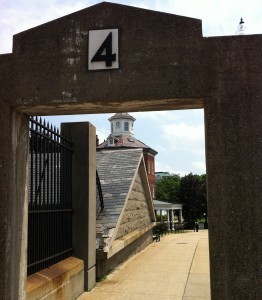
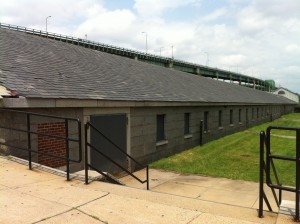
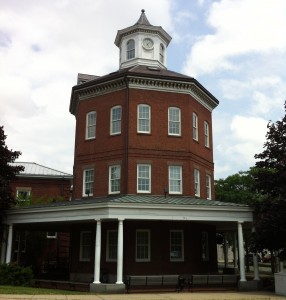
Heading to the northeast along Second Avenue, we enter a large cluster of buildings used for everything from offices to workshops to storage to forges. No longer part of the Navy Yard, these buildings are being converted to civilian use. Mary works in a fictional office in Building 39.
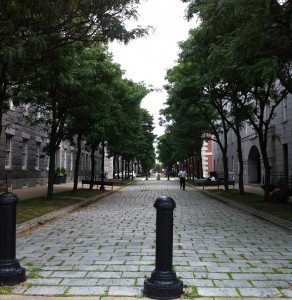
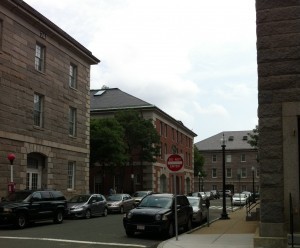
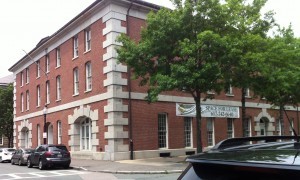
Ships at the Boston Navy Yard were constructed in two different methods. Ships could be constructed on shipways, with above-ground scaffolding, and launched “down the ways” into Boston Harbor. Ships could also be constructed in dry docks, large basins with a caisson at the end to keep the seawater out. To launch the ship, water was pumped through the caisson into the dry dock to float the ship. Then the caisson was removed, and the ship sailed out. Alternately, a ship could pull in to a flooded dry dock for repairs. The caisson was positioned, and water was pumped out. This was done on 17 May 2015 at the Charlestown Navy Yard for the restoration of USS Constitution. You can see a fun time-lapse video of the process here. Dry Dock 1 was constructed in 1833, and Dry Dock 2 in 1905. More were added later.
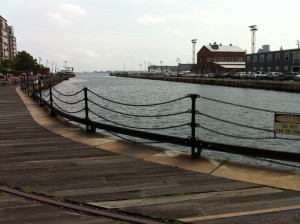
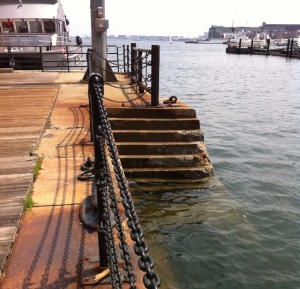
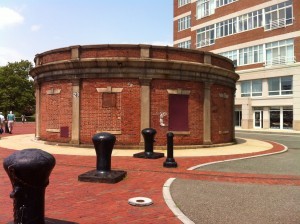
The Charlestown Navy Yard was responsible for the construction and repair of thousands of ships. From 1939-45, six thousand ships were constructed, repaired, or outfitted. At the start of World War II, women worked at the Navy Yard only as telephone operators or in clerical positions (like Mary). As the war progressed, women were hired for more types of jobs. At the peak in 1943, the Boston Navy Yard employed 50,000 people, 20 percent of whom were women.

Today the Charlestown Navy Yard is an essential stop for the Boston tourist. The USS Constitution, flagship of the US Navy, has called Boston her home port since 1897 (see my post here), and the World War II era destroyer USS Cassin Young has been docked there since 1978 (see my post coming August 3). Both the Charlestown Navy Yard Visitor Center and the USS Constitution Museum are well worth a visit, especially with children. For fun, take the ferry from downtown Boston to the Navy Yard!
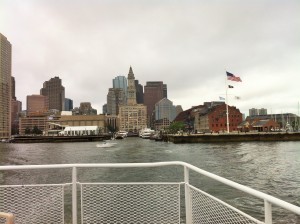
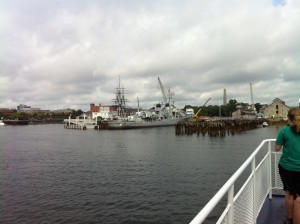
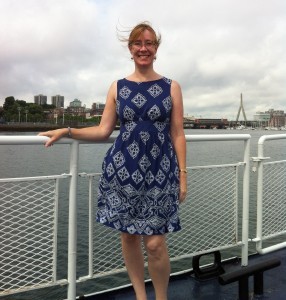
Sources:
Boston National Historical Park, Charlestown Navy Yard: http://www.nps.gov/bost/learn/historyculture/cny.htm
Bither, Barbara A., Boston National Historical Park. Images of America: Charlestown Navy Yard. Charleston, SC: Arcadia Publishing, 1999.
Boston National Historical Park. Charlestown Navy Yard. Washington, DC: Division of Publications, National Park Service, U.S. Department of the Interior, 2010.
 Giveaway
GiveawayI’m giving away this adorable vintage Through Waters Deep apron, made by my talented author-buddy Marci Seither, and modeled by her lovely daughter! To enter, leave a comment below (US & Canada only please), or on next week’s Destroyer Tour posts, which will show pictures from World War II destroyers, as in the novel. You can earn a maximum of three entries by leaving a comment on each of the three posts. If you can’t leave a comment, please send me an email to enter. Giveaway ends Wednesday, August 5, 2015 at midnight, Pacific Time. I’ll announce the winner here on Friday, August 7, 2015.



